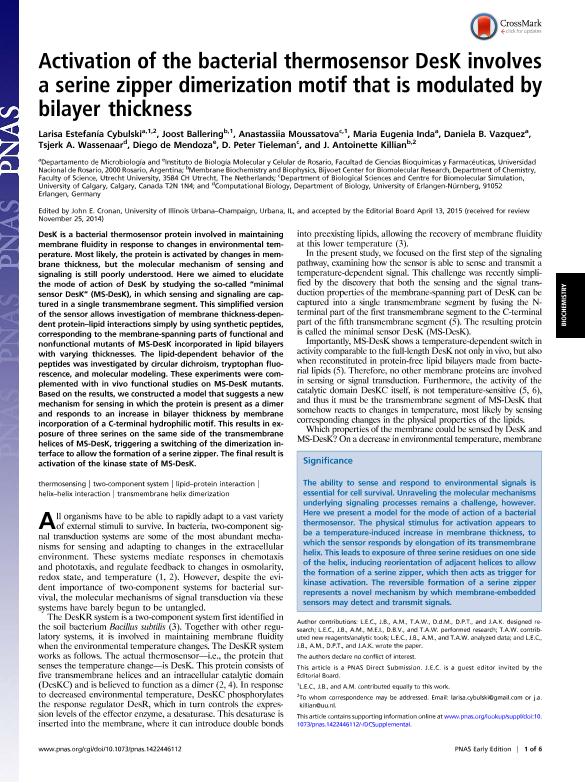Mostrar el registro sencillo del ítem
dc.contributor.author
Cybulski, Larisa Estefania

dc.contributor.author
Ballering, Joost
dc.contributor.author
Moussatova, Anastassiia
dc.contributor.author
Inda, María Eugenia

dc.contributor.author
Vázquez, Daniela Belén

dc.contributor.author
Wassenaar, Tsjerk A.
dc.contributor.author
de Mendoza, Diego

dc.contributor.author
Tieleman, D. Peter
dc.contributor.author
Killian, J. Antoinette
dc.date.available
2018-06-25T15:45:48Z
dc.date.issued
2015-05
dc.identifier.citation
Cybulski, Larisa Estefania; Ballering, Joost; Moussatova, Anastassiia; Inda, María Eugenia; Vázquez, Daniela Belén; et al.; Activation of the bacterial thermosensor DesK involves a serine zipper dimerization motif that is modulated by bilayer thickness; National Academy of Sciences; Proceedings of the National Academy of Sciences of The United States of America; 112; 20; 5-2015; 6353-6358
dc.identifier.issn
0027-8424
dc.identifier.uri
http://hdl.handle.net/11336/49914
dc.description.abstract
DesK is a bacterial thermosensor protein involved in maintaining membrane fluidity in response to changes in environmental temperature. Most likely, the protein is activated by changes in membrane thickness, but the molecular mechanism of sensing and signaling is still poorly understood. Here we aimed to elucidate the mode of action of DesK by studying the so-called "minimal sensor DesK" (MS-DesK), in which sensing and signaling are captured in a single transmembrane segment. This simplified version of the sensor allows investigation of membrane thickness-dependent protein-lipid interactions simply by using synthetic peptides, corresponding to the membrane-spanning parts of functional and nonfunctional mutants of MS-DesK incorporated in lipid bilayers with varying thicknesses. The lipid-dependent behavior of the peptides was investigated by circular dichroism, tryptophan fluorescence, and molecular modeling. These experiments were complemented with in vivo functional studies on MS-DesK mutants. Based on the results, we constructed a model that suggests a new mechanism for sensing in which the protein is present as a dimer and responds to an increase in bilayer thickness by membrane incorporation of a C-terminal hydrophilic motif. This results in exposure of three serines on the same side of the transmembrane helices of MS-DesK, triggering a switching of the dimerization interface to allow the formation of a serine zipper. The final result is activation of the kinase state of MS-DesK.
dc.format
application/pdf
dc.language.iso
eng
dc.publisher
National Academy of Sciences

dc.rights
info:eu-repo/semantics/openAccess
dc.rights.uri
https://creativecommons.org/licenses/by-nc-sa/2.5/ar/
dc.subject
Helix-Helix Interaction|
dc.subject
Lipid-Protein Interaction|
dc.subject
Thermosensing|
dc.subject
Transmembrane Helix Dimerization
dc.subject
Two-Component System|
dc.subject.classification
Otras Ciencias Biológicas

dc.subject.classification
Ciencias Biológicas

dc.subject.classification
CIENCIAS NATURALES Y EXACTAS

dc.title
Activation of the bacterial thermosensor DesK involves a serine zipper dimerization motif that is modulated by bilayer thickness
dc.type
info:eu-repo/semantics/article
dc.type
info:ar-repo/semantics/artículo
dc.type
info:eu-repo/semantics/publishedVersion
dc.date.updated
2018-06-25T12:39:27Z
dc.journal.volume
112
dc.journal.number
20
dc.journal.pagination
6353-6358
dc.journal.pais
Estados Unidos

dc.journal.ciudad
Washington
dc.description.fil
Fil: Cybulski, Larisa Estefania. Consejo Nacional de Investigaciones Científicas y Técnicas; Argentina. Universidad Nacional de Rosario. Facultad de Ciencias Bioquímicas y Farmaceuticas. Departamento de Microbiología; Argentina
dc.description.fil
Fil: Ballering, Joost. University of Utrecht; Países Bajos
dc.description.fil
Fil: Moussatova, Anastassiia. University of Calgary,; Canadá
dc.description.fil
Fil: Inda, María Eugenia. Consejo Nacional de Investigaciones Científicas y Técnicas; Argentina. Universidad Nacional de Rosario. Facultad de Ciencias Bioquímicas y Farmaceuticas. Departamento de Microbiología; Argentina
dc.description.fil
Fil: Vázquez, Daniela Belén. Consejo Nacional de Investigaciones Científicas y Técnicas; Argentina. Universidad Nacional de Rosario. Facultad de Ciencias Bioquímicas y Farmaceuticas. Departamento de Microbiología; Argentina
dc.description.fil
Fil: Wassenaar, Tsjerk A.. University of Erlangen-Nürnberg; Alemania
dc.description.fil
Fil: de Mendoza, Diego. Consejo Nacional de Investigaciones Científicas y Técnicas. Centro Científico Tecnológico Conicet - Rosario. Instituto de Biología Molecular y Celular de Rosario. Universidad Nacional de Rosario. Facultad de Ciencias Bioquímicas y Farmacéuticas. Instituto de Biología Molecular y Celular de Rosario; Argentina
dc.description.fil
Fil: Tieleman, D. Peter. University of Calgary,; Canadá
dc.description.fil
Fil: Killian, J. Antoinette. University of Utrecht; Países Bajos
dc.journal.title
Proceedings of the National Academy of Sciences of The United States of America

dc.relation.alternativeid
info:eu-repo/semantics/altIdentifier/doi/https://dx.doi.org/10.1073/pnas.1422446112
dc.relation.alternativeid
info:eu-repo/semantics/altIdentifier/url/http://www.pnas.org/content/112/20/6353
Archivos asociados
